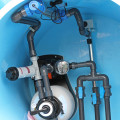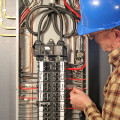Performing an electrical service panel upgrade or upgrading your service panel is an important task that must be done on every home to ensure that your home electrical circuits are always safe. But, what are the best practices and guidelines that should be followed?
Electrical Service Panel Guidelines and Information
Do you really need a sub-contractor to do this work? Do you require any permits? What costs are involved? What problems are likely to occur? Well, here we provide all the answers to your questions and solutions, offering the best advice and guidelines that you should follow when you require this kind of work done.
 The following are the most important details that you should follow to ensure that the job gets done professionally and correctly, and these items should also be included in any contracts and contractor work checklists, and tied to payments:
The following are the most important details that you should follow to ensure that the job gets done professionally and correctly, and these items should also be included in any contracts and contractor work checklists, and tied to payments:
- Before the start of any work, you should make sure that the location, layout, style and appearance of the panel, and any materials used are correct and approved with the contractor.
- Ensure that all the electrical elements including connectors, fasteners, and other items used are fully compatible with the new panel.
- The guidelines stipulate that the panel must be flush to the mounting surface, and that the base and trim are completely and properly attached.
- Neat, uniform cut outs will be made as per the panel upgrade guidelines so that no air gaps are evident and that the panel is not visible when the cover plates are installed. Any large gaps and spaces must be insulated and sealed.
- The new panel must be anchored securely to its structural framing.
- Make sure it will conform to manufacturer’s requirements, and will operate correctly.
- According to the guidelines, all work must meet or exceed any and all code requirements.
- It must be correctly grounded with proper polarity in order to deliver the correct voltage.
- The correct size wiring will be used to ensure full design performance and safe operation of the panel.
FAQ’s
These are just some of the commonly asked questions relating to the upgrade of an electrical service panel:
Do You Need a Permit?
Usually some kind of permit or design approval is required from your local building office for the installation of a new panel, so you will need to find out and apply for one before you start any work. The contractor you hire for the job should organize this for you.
 Can I Do the Job Myself?
Can I Do the Job Myself?
No, this is not the kind of job that you can do yourself, no matter how proficient you are. The installation of an electrical service panel requires the expertise of a professional who uses the correct tools, materials and fabrication methods as set out in the upgrade guidelines. Any DIY mistakes will result in the loss of marketability of your home as well as decrease the value, plus it will be very costly to fix.
Do I Need to Hire a Professional Electrical Contractor?
Yes, you must be very thorough when it comes to selecting the professional contractor to perform this task. They must be highly experienced and know how to install the panel correctly to ensure optimal performance.
What Can I Expect to Pay for This Work?
The installation of a new electrical service panel can cost anywhere between $320 and $1000 per panel, and this all depends on the time of year, the size of the project, the location and quality of workmanship. You are also looking at additional fees for rush jobs.
How Long Does the Upgrade Usually Take?
You can expect an installation to take between 1 and 3 days depending on the scope of the job.
Panel Upgrade Guidelines for Milestones and Project Reminders
The tasks listed below are what normally get completed during the installation of an electrical panel. You should use these tasks to ensure that the job is completed properly and complies with all vendor or manufacturer warranty requirements. These tasks or milestones should be listed in the contract work order in the following order, and ticked off and paid for as they are completed.
- The written contract outlining the job, detailing the materials and tools used, including information about quality checks and warranties, as well as payment terms must be drafted and signed by both parties before work commences.
- Next you will need to choose and order the new panel that you want. The order should clearly identify the grade, type, size, color, finish, and other options, as well as the quantity. Additionally the delivery date and terms are included, as well as damage insurance details.
- Once the service panel is delivered, the details must all be verified against the order to ensure that the correct item was delivered. A thorough inspection of the service panel must take place to assess any damage and correct operation. The final payment for the panel can now be authorized.
- Now that you have the panel, you must confirm a start date and time for the sub-contractor, which is usually a week prior to the start date.
- Get the permits required from your local building authority and post this on the job site as required.
- When the sub-contractor comes in, they should install it using corrosion resistant screws as per local building codes and manufacturer guidelines.
- Schedule an inspection of the new upgrade.
- Any permit issues must then be corrected to bring it up to code after which a final inspection must be scheduled.
- The inspection to verify that all the quality panel upgrade guidelines are met must be done also ensuring that the check list items are completed correctly.
- Connect the electrical panel to the power using a hardwired connection in the closed junction box or grounded receptacle.
- The circuits must then be clearly labeled as per the upgrade guidelines with the circuit type and the area.

With these questions, checklist details, and service panel upgrade guidelines, the process of getting a new service panel installed should be simple and hassle free. See this page for more information.





